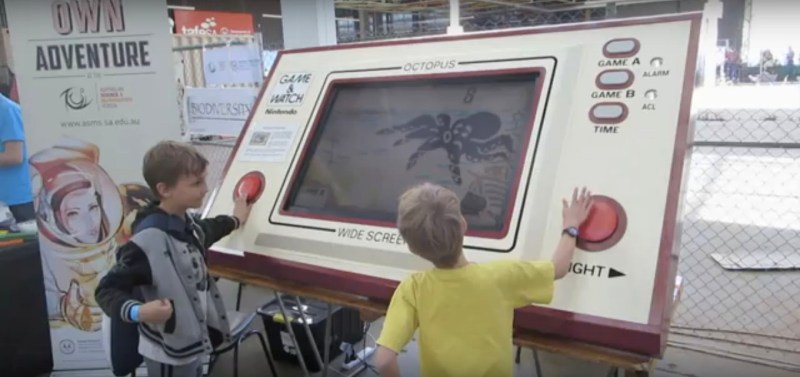Today we’re used to handheld game consoles like the Nintendo Switch, that let you roam around in 3D worlds which include not only 3D players but more terrain than many people walk around in real life in a week. But back in the early 1980s Nintendo’s handheld offering was the Game & Watch, which used a segmented LCD display. An entire segment could be used to represent the player, with player segments spread throughout the display. To move the player, the previous player segment would be turned off while another adjacent one would be on. That also meant that a console could play only one game. Despite these limitations they were very popular for their time.
[Thomas Tilley] decided to improve on the old Game & Watch in a different way, by making it bigger, much bigger. So big in fact that even many teenage players can’t reach both the button to move left and the button to move right in time, turning it into a highly co-operative two-player game. Judging by the video below, that made playing it double the fun. The game he chose to tackle is the Game & Watch Octopus, or Mysteries of the Sea and Mysteries of the Deep in the UK.
The screen he’s using is still an LCD one, but a modern 46″ LCD TV with far smaller, pixel-sized segments. This sits behind sheets of plywood. Rather than paint the plywood, [Thomas] opted to cover it in gold curtains supplied by his mother-in-law. That meant getting some custom made iron-on transfers for the letters, numbers, and various lines on the front of the console. Most of these he could apply using an iron, but there were some places the iron couldn’t fit. For those areas he stuck an IKEA hex key into his soldering iron and used the hot hex key to apply the heat to the transfer. The buttons are also plywood, mounted with springs so that they can be pushed in. When pushed, they activate long-armed micro switches. These in turn are wired to a hacked gamepad that connects to the laptop via USB.
If you’re looking for a more manageable handheld Game & Watch hack then check out this one by [Andrew] that’s around the same size as the original, but has its own distinct look.

















That’s awesome.
One Christmas my siblings and I were treated to a game and watch game each from our uncle and aunty and my sister got Octopus- unfortunately it met an early demise after tumbling down a flight of concrete stairs :(
I wonder how the managed to reproduce the appearance of the non backlit black and white LCD on the modern TFT monitor.
It’s definitely a cool effect.
Looks like a TFT monitor with B/W image and backlight turned off. The image is kinda dim, which looks like the monitor probably wasn’t modified, but I could be wrong. Just figured it might be intact since bezel is still in place.
It is just a 46″ LCD TV and it is a colour image – I didn’t make any special adjustments. A number of people who were there on the day asked how the screen was done because it looked a lot like the original LCD. It’s largely due to the great job that Hipopotam did with the look of the Flash simulation (http://pica-pic.com/#/octopus/).
Some of the game&watch games are actually fun to play. Perhaps nostalgia…
IIRC, I had that particular “watch”, it was a waste of time.
No pun intended.
AHHHHHH!!! This is so cool. A how much fun to see those youngsters play something from my youth.
Really a beautiful a orignal looking build. A project well done!
Thanks for posting.